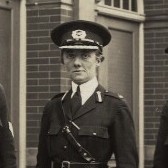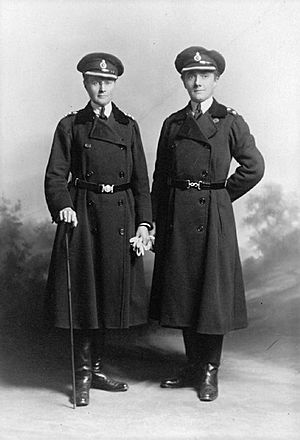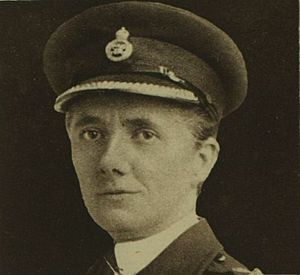Mary Sophia Allen facts for kids
Quick facts for kids
Mary Sophia Allen
|
|
|---|---|
 |
|
| Born | 12 March 1878 |
| Died | 16 December 1964 (aged 86) |
Mary Sophia Allen OBE (born March 12, 1878 – died December 16, 1964) was a British activist. She was known for supporting women's rights in the early 1900s. Later, she became involved with British fascism. She is best known as one of the first leaders of the Women's Police Volunteers. Allen often tried to change old systems. She helped the Women's Police Service become an official helper force. This happened after women were allowed into some British police forces. She once ran for Parliament as an independent. She used her Women's Auxiliary Service to help during the General Strike of 1926. Later, she met and talked with European fascists. She joined the British Union of Fascists in 1939. In her later years, Allen worked for animal rights.
Contents
Early Life and Women's Rights
Mary Allen was born in Cardiff, Wales, in 1878. Her family was quite wealthy. She was one of ten children. Her father, Thomas Isaac Allen, was a chief superintendent for the Great Western Railway. Mary and her sisters were very close. They were all interested in religious mysticism. Mary was taught at home. She also went to Princess Helena College.
In 1908, when she was 30, Mary left home. She had a disagreement with her father about women's suffrage. This was the movement for women to get the right to vote. She did not go back home until her father died in 1911.
Allen joined Emmeline Pankhurst's Women's Social and Political Union. This group fought for women's right to vote. Mary became an organizer for them in the South West of England and later in Edinburgh, Scotland. She was put in prison three times in 1909 for protesting strongly. She went on hunger strike twice. During her last hunger strike, she was force-fed. For her bravery, she received a Hunger Strike Medal from Emmeline Pethick-Lawrence. While in prison, she and others secretly sewed messages like 'Votes for Women' into prison shirts.
Police Work During World War I
When World War I started, the women's suffrage protests stopped. Allen turned down a quiet job. She looked for something more active. She heard that women were trying to start a women's police force. In 1914, she joined Nina Boyle's Women Police Volunteers. In 1915, Margaret Damer Dawson took over this group. It was renamed the Women Police Service (WPS). Allen became the second-in-command.
They created their own uniform. They also opened training schools in London and Bristol. Allen worked in places like Grantham and Kingston upon Hull. Her job was to watch over women near army camps. She also policed factories that made weapons. These factories employed many women. She worked in London too, where some people worried about young women's behavior. The WPS also helped with child welfare. They set up a special department and a home for mothers and babies. Allen received the OBE award for her service during the war.
Allen and Margaret Damer Dawson cut their hair short. They looked very serious and military-like. Allen wore her police uniform in public for the rest of her life. When Dawson died in 1920, Allen became the WPS Commandant. After the war, many expected the WPS to close down. The government thought they were no longer needed. The Metropolitan Police started its own women's division. They accused the WPS of pretending to be Metropolitan police officers. Allen was even arrested in 1921 for wearing a Metropolitan Police uniform. However, it was decided that her work was harmless. She was allowed to keep wearing it.
The WPS changed its name to the Women's Auxiliary Service (WAS). They made small changes to their uniform. They continued their work, opening another training school in Edinburgh. The government set up a committee to look into the WAS's activities. Even though the authorities no longer officially recognized her, Allen was asked by the government to go to Germany. She was to advise on policing the British Army of the Rhine. This unofficial acceptance made her represent herself overseas as the chief of British women police. She traveled in uniform. Police authorities in Europe, South America, and North America welcomed her.
Later Life and Political Views
In November 1922, Allen tried to become a Member of Parliament. She ran for the Westminster St George's area but did not win. During the General Strike of 1926, Allen helped with the Organisation for the Maintenance of Supplies. She used her Women's Auxiliary Service to help break the strike.
Allen learned to fly an airplane. She went to international police meetings in Austria and Germany. She also visited the Netherlands, Hungary, Czechoslovakia, Turkey, and Brazil. She gave advice on training police women. In 1936, she went to Egypt on holiday, wearing her uniform. She was received as if she were sent by the British police.
The Home Office started watching Allen's activities in 1927. She was becoming a problem for the government. This was partly because people abroad thought she represented British authorities. Also, people at home sometimes mistook her for a Metropolitan police officer. Records from 1927 to 1934 show she kept files on people she suspected of certain activities. She was also suspected of fascist activities. Articles about her in newspapers led to more government surveillance.
Allen met several fascist leaders abroad. These included Eoin O'Duffy in Ireland, Francisco Franco in Spain, Benito Mussolini in Italy, and Adolf Hitler and Hermann Göring in Germany. Her links to Oswald Mosley's British Union of Fascists were not official until 1939. However, she took part in various activities. This included forming the Women's Reserve in 1933. This group was meant to serve the country if "subversive forces" took over. Her public statements about the Women's Reserve showed her fascist sympathies. They also showed her fear of communism.
She met Hitler in 1934 and talked with him about women police. She admired Hitler and said so publicly. After she joined the British Union of Fascists, she wrote many articles for their newspapers. She openly said she was a fascist. An order was made against her during World War II. This was because of suspicions about her contacts with Germany. Her home was searched. The government thought about putting her in prison, but they did not. She was suspected of flying to Germany and spying for the Nazis. However, this was never proven.
After World War II began, Allen joined the Women's Voluntary Service. But she also spoke regularly at British Union of Fascists peace rallies. Newspapers like the Daily Herald and Daily Mirror were outraged. They called for Allen to be removed from the WVS. This was especially after she refused to criticize Hitler in public comments. Because of her close ties to Mosley, the police suspected Allen. There were also questions in Parliament in June 1940. People wondered if Allen's presence on the Advisory Council of the Women's Voluntary Service was a security risk. After looking at her activities, the government decided not to imprison her. The final report called her a "crank" in a "ridiculous uniform." However, she was later placed under a lesser form of restriction. She had to stay within five miles of her home in Cornwall. She was also banned from using cars, bicycles, telephones, and the radio.
Personal Life and Legacy
Mary Allen was known as 'Robert' by her close female friends. Her officers called her 'Sir'. Her friends included Margaret Damer Dawson, Isobel Goldingham, and Helen Bourn Tagart. She met all of them during her police work. She wrote three books about her life: The Pioneer Policewoman (1925), A Woman at the Cross Roads (1934), and Lady in Blue (1936). A Woman at the Cross Roads shares parts of her life and ideas. It was written when Allen met Hitler. Her political views are clear in the book. She felt she was at a crossroads in her life. She saw fascism as a way to solve the world's problems. She also wrote many articles for newspapers and magazines. She started The Policewomen’s Review, which ran from 1927 to 1937. She wrote a lot for this publication.
After World War II, not much is known about Allen's personal life. She remained connected to Mosley and other fascists. This included Norah Elam, who was a lifelong friend. Both had been members of the WSPU. As strong supporters of women's suffrage, they had both been force-fed during hunger strikes. After the Mosley movement ended, they both became active in animal rights. They were strongly against vivisection (animal testing). They were members of the London and Provincial Anti-Vivisection Society. Mary Allen always had a strong interest in religion. She became a Roman Catholic in 1953. She died in a nursing home in Croydon at age 86. Her sister, Christine, was with her.



